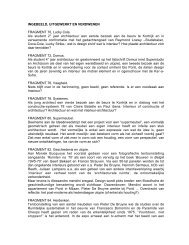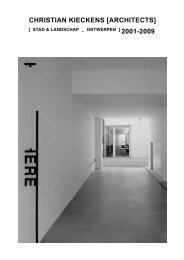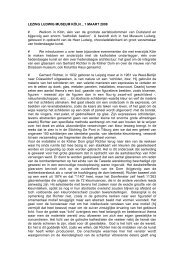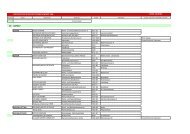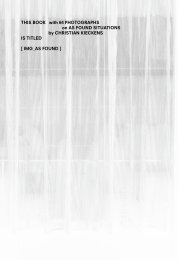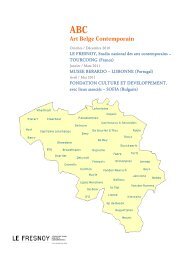download pdf - Christian Kieckens Architects
download pdf - Christian Kieckens Architects
download pdf - Christian Kieckens Architects
You also want an ePaper? Increase the reach of your titles
YUMPU automatically turns print PDFs into web optimized ePapers that Google loves.
HERE / AND, ANDHERE / AND, AND(Two room pieces)AS] THENFROM [TO]essence of Downsbrough’s work: the direct distance between the very subject andseeing this subject / HERE, AND.Yet it is especially the third meaning which moves as an underlying layer throughoutthe entire film: the reflective contextual character of the place of occurrence and thecognitive which can be observed and stored : TO CONTAIN / AS.And, no less than these three levels of readings, a role has been assigned to thetexts, the three voices and the three visual rhythms which each coincide at specificmoments, and which only then reveal the essential actual theme in this work, andthat is that the meanings of the words haven’t been assigned.Considering all this, “OCCUPIED” deals with the ultimate of a neutral empty space,Brussels’ Administrative Center, an urban non-place occupied by a significantmassive emptiness, in which modernist-inspired buildings form a reflective framefor a space which once formally occupied a part of the city, but which here has beentransformed (by the film into the mind) into a thought pattern which each user leavesbehind as s/he confronts her/his own consciousness.Even if they share the same title, these two room pieces in private settings generatea totally different use. The first piece (2001) encompasses the entire space of anapartment with a view to the horizon line of the sea. The interior contains a number ofsliding walls and for this reason the space is variable and the piece itself participatesin its changing character. Moving the walls causes lines to split, words to find theirmeanings in the adjacent space, and supplementary spaces in between to becomeavailable. This interior, designed by Claire Bataille and Paul Ibens, is, in fact, apiece of general architecture in which main spaces and pocket spaces are linkedto one another. It is the old principle of a space that serves and is being served.Downsbrough takes advantage of this situation by using specific relationships togive the walls as planes and the space in its third dimension a different system thansimply intervening on the surface. Because of the piece, all verbs relating to theinterior, such as “to sit,” for instance, are assigned their own “place”: HERE.A second room piece (2001) is situated in the back room of an apartment on theeighth floor with an urban view. Here, the space -- an average room with a windowand a door -- has been taken for the work in its totality. Splitting the word HEREbetween the glass door and window leads to a double relationship: looking outsidefrom inside, the city is taken into the HERE as an event, while light and sun projectits shadow towards the room’s interior. Here the room is important: the inhabitantis literally in the middle of the work and participates integrally. Lines with tape,letters and a metal pipe are, here, too, part of the work, thus questioning the basicdimensions and proportions of the room as a standard container for living.The works raise questions not only about form and meaning, but also about about theownership of art. While the concept of these pieces remains the artist’s property, Herecan’t actually be possessed or “collected,” only experienced and lived with. Unlikea painting one can take along or a book that goes in any library, it is a specificallyconceived piece that can be adapted to another space.Recently, Downsbrough has been making videos in which he articulates the worldof the movements between several cities. AS] THEN (2003) is about a site wedgedbetween Brussels’ South Station and the future Arts Center Wielemans-Ceuppens.Moving trains alternate with views of the intersection below, with its busy vehiculartraffic. Contrasting with the compactness of the trains are fleets of trucks shot inLas Vegas. The busy traffic positions itself against the meaninglessness and theemptiness of the landscape.In FROM [TO] (2003) there are rows and rows of trucks moving as a landscape-likewall on the right lane of a highway with the necessary slowness. In an interview withSarah McFadden, 3 Downsbrough tells about this particular video:That film is very much about the passing of time, but it’s also the journey “From/To”,and the traffic and merchandise moving by truck. It all came about from driving onthe highway between Lille and Ghent, and encountering those solid walls of truckswhere the road narrows to two lanes. Of course it’s ultimately boring to film just that,so I shot part of it in a container park and located some other truck situations: Volvocabs parked in neat rows for the weekend before going out again. Movement and thepassage of time.… It’s about the economy -- its structure, organization and architectonics. I’m workingon a trilogy based loosely around architecture, transportation, highways and themovement of goods. Railroads, the highway system, shopping areas, administrationbuildings ...It’s a necessary situation, that flow. Without it, what would we do? How to get thosematerials distributed without disrupting the planet that we’re trying to inhabit? Manis a peculiar animal. He can’t live off the land without building a house. Most typesof animals group together, but man does so even more, in cities. The city to him ismuch more natural than the forest. There’s nothing unnatural about cities. I don’t livein agrarian nature, I live in 21st -century urban nature. I think we have to stop sayingthat it’s not natural. The nature of that nature has to be articulated -- we can’t refuseit out of hand.As to how cities are configured and governed, why and by whom -- we have torecognize it and talk about it openly.And thus the place of the event tells about a non-place. Therefore, Peter Downsbrough’swork can be called atopic: it can be placed but not seized in a determined fixedplace, it always relates to a specific architectural context and is linked with thesocial circumstances of the “place,” always at a distance, as an act both away anddispersed as well as close and connected. Brussels, New York, Lille in one mutualcontextual occurrence/ event, in which the satisfaction of possession is manifestedin the very work through non-possession. Art as a sign of meaning.(ed. Sarah McFadden)The title is a reworking of the title of Sophie Lissitzky-Küppers “LIFE. LETTERS. TEXTS.”on the occasion of a discussion about the work of El Lissitzky.ENDNOTES1Sarah McFadden, from an interview with Peter Downsbrough commissioned by FRACBourgogne for the catalogue 1:1 x temps, quantités, proportions et fuites, Dijon, 2004,excerpts of which have been published in Espace de Libertés, nr 319, Brussels University(ULB) , 2004.2Raymond Balau, Densities, Imschoot, uitgevers, Ghent, 1996.3Peter Downsbrough in conversation with Sarah McFadden, loc. cit.



